Righteye Flounders: Family Pleuronectidae
Species: Platichthys stellatus (Pallas, 1787); from the Greek words platy (flat) and ichthys (fish) and the Latin word stellatus (starry).
Alternate Names: Rough-jacket, great flounder, grindstone, emery flounder, emerywheel, leatherjacket, English sole, sand paper flounder, diamondback, long-jaw flounder, California flounder, swamp flounder and (too simple) flounder.
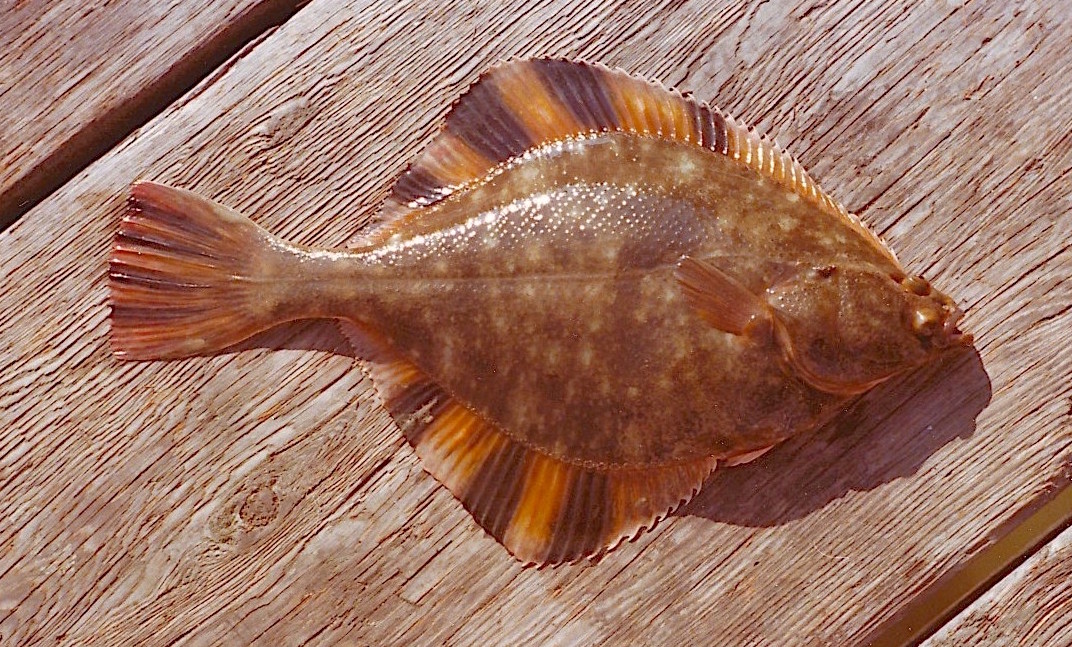
Starry Flounder from the Joseph’s Fishing Resort Pier in Rodeo (where I used to fish) – 1975
Identification: Most easily distinguished by the alternating orange and black stripes on the fins. In addition, there are patches of very rough scales throughout the pigmented side of the body. Considered a member of the right-eye flounder family but sixty percent have eyes on the left side.
The question of left side right side raises a question. Off Japan nearly 100% of the starries are left eyed (sinistral); off Alaska the number drops to 67%; off the West Coast of the U.S. the number drops to 5-60%. Is it environmental or genetic? Scientists don’t know the answer.
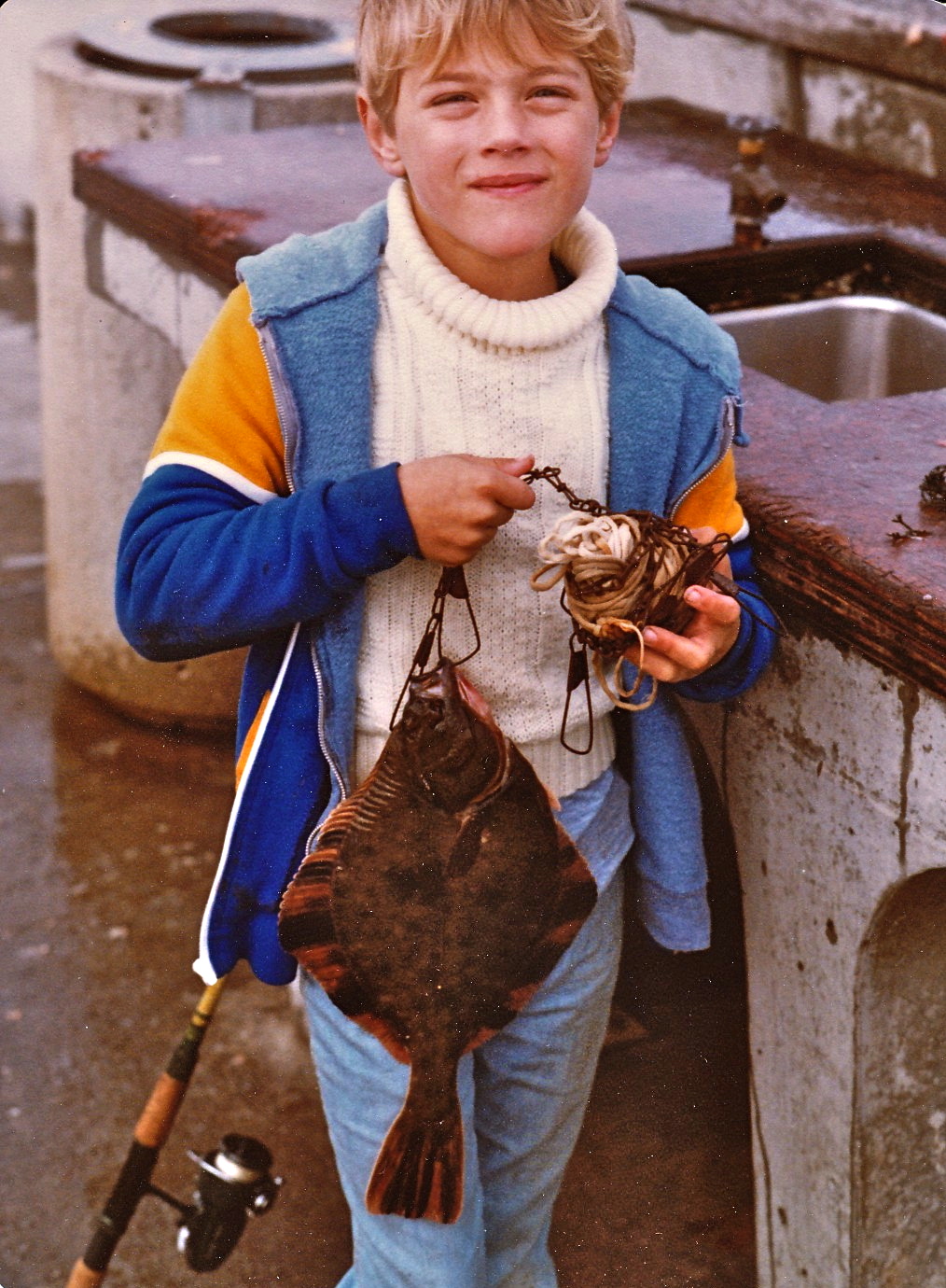
My son Mike and a starry flounder from the Pacifica Pier in 1977
Size: To 36 inches and over 20 pounds but most caught from piers are under 18 inches. The California record fish weighed 11 lb 4 oz and was caught at San Simeon in 1993. The IGFA World Record fish weighed 10 Lbs 9 oz and was takin at Bolinas, CA in 2007.
Range: The range of these fish is somewhat amazing extending into the far northern regions of the Arctic Ocean and east into Asia. Los Angeles Harbor, southern California to the Commander-Aleutian Islands, Alaska, west through the Bering Sea, southeast to the Sea of Okhotsk, Russia, and the Sea of Japan (off the Korean Peninsula and Japan), north to the Beaufort Sea and Arctic Ocean, northwest to the East Siberian Sea, Russia, northeast at least to Bathhurst Inlet, Nunavut and Count Melville Sound, Canada. They are uncommon south of Point Conception. Starries can also travel quite a way up streams. Some were observed in the San Luis Reservoir and O’Neill Forebay apparently having been transported there via the California Aqueduct after traversing the Sacramento-San Joaquin Delta.
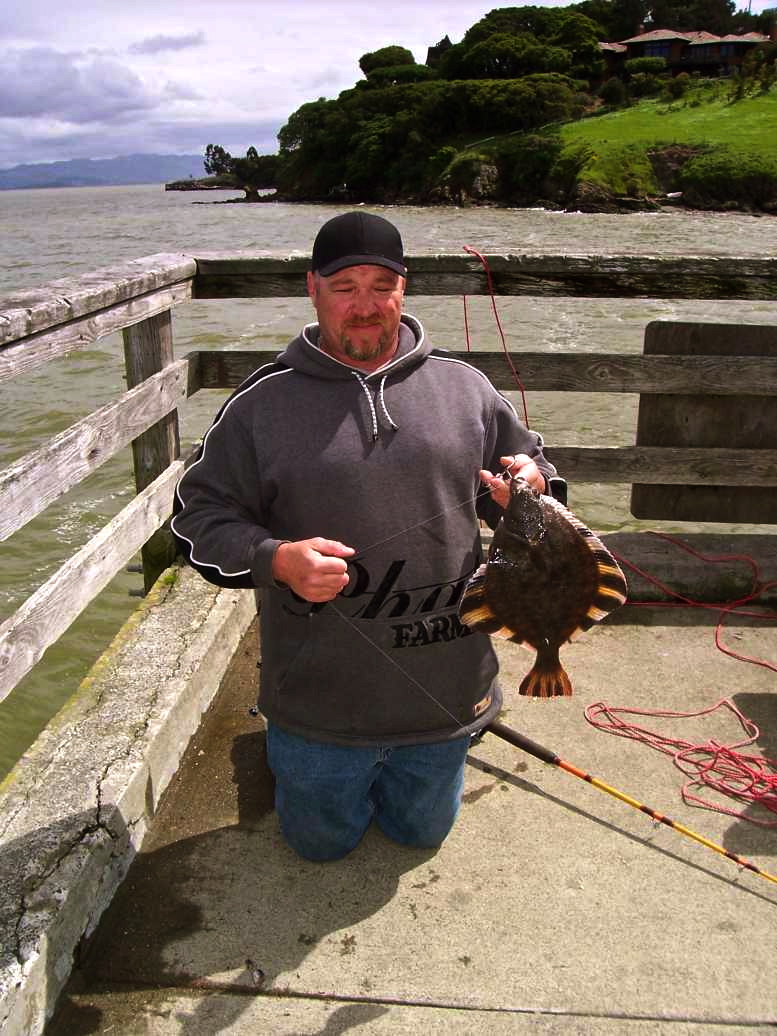
Starry flounder caught by Thnderr in 2005 from the Paradise Park Pier
Habitat: Although found to a depth of 1,968 feet, they are most common in shallow-water areas, primarily those with sand, mud and eelgrass. They are an euryhaline species capable of tolerating a wide range of salinities and are frequently found in bays and estuaries and are especially prevalent around the mouths of streams and rivers in the winter and early spring (December to March). It is also reported that starry flounder sometimes hybridize with English sole producing the Hybrid Sole, Inopsetta ischyra.
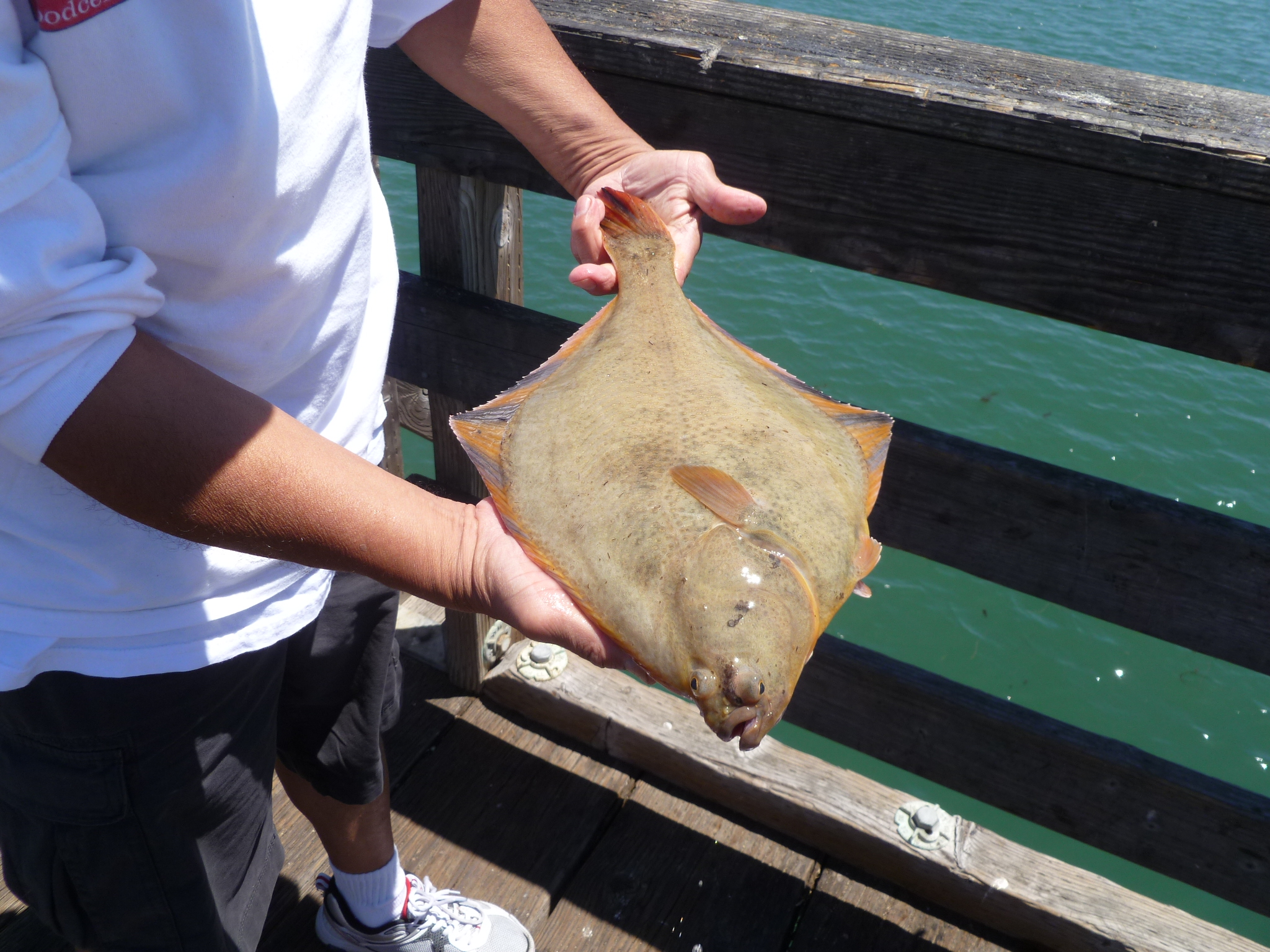
Starry Flounder or Hybrid Sole? Caught at the Capitola Wharf in 2012 — Picture courtesy of Capitola Bait & Tackle store
Piers: Once common in central and northern California but far less common today. Best bets: Cayucos Pier, San Simeon Pier, Capitola Wharf, Santa Cruz Wharf, Pillar Point Pier, Berkeley Pier, Point Pinole Pier, Martinez Pier, McNear Beach Pier, Paradise Beach Pier, Adorni Pier, and the “B” Street Pier in Crescent City.
Shoreline: Once a common shore catch by anglers in San Francisco and Humboldt Bay but today far less common.
Boats: Once a favored fish for boaters in the San Francisco Bay Area but numbers have dropped dramatically over the years.
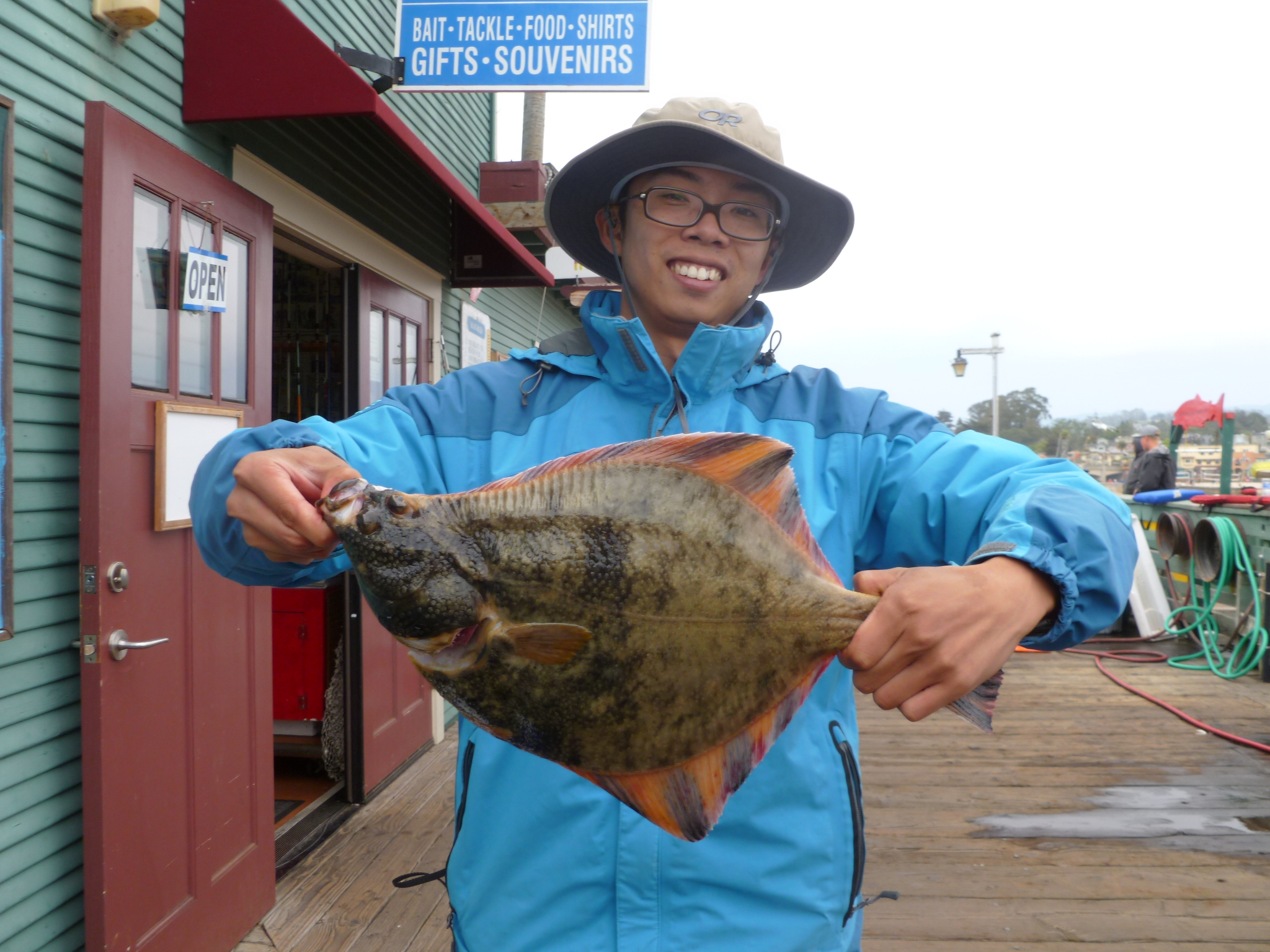
Starry flounder caught at the Capitola Whaf in 2013 — Picture courtesy of the Capitola Bait & Tackle Store
Bait and Tackle: Once heavily fished in the San Francisco Bay Area although numbers have dropped. The most common rigging is a sliding live bait leader baited with pile worms, live grass shrimp or ghost shrimp. Many are also taken on high/low leaders baited with pile worms, grass shrimp, ghost shrimp, cut anchovy, squid, or even pieces of market shrimp. Medium-size tackle with number 4 or 2 hooks is adequate.
Some are also taken on artificial lures. In Coastal Fishes of the Pacific Northwest by Andy Lamb and Phil Edgell it’s reported that “small spinners slowly retrieved near the sandy bottom also attract this good light-tackle battler. Fly fishermen seeking a novel experience can sometimes catch this inhabitant of shallow water when it rises to the surface at night, attracted either by pier lights or the small prey congregating there.” I’ve never heard of similar fishing in northern California bays but it may be possible.
Another book, one that was a favorite of mine when I was young, is Anglers Guide To The Salt Water Fishes by Edward C. Migdalski. In his discussion of starry flounder he writes, “during one expedition to Unimak Island in the Aleutians, Larry Sheerin and I experienced some wonderful sport with the starry flounder. We were fishing primarily for dolly varden trout as we cast small spoons into a fairly large and rapid river which emptied into the sea a couple of miles further down. We caught many good-sized dolly varden, which put up a splendid battle in such cold swift water, but the occasional large starry flounders that grabbed our lures out-scrapped the trout!”
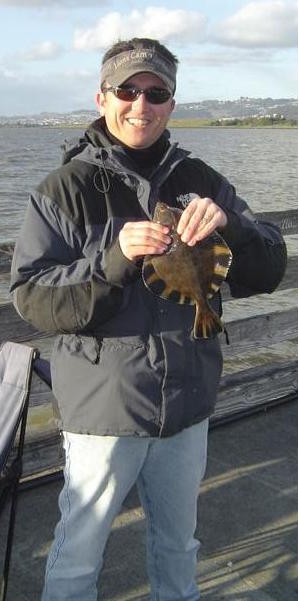
Starry flounder caught at the Berkeley Pier by Jay in 2006
Food Value: Generally good although some have only a fair flavor. This is another fish that may be unsafe to eat in areas with heavy pollution. Best fried or baked.
Comments: Young starries apparently subsist mainly on a diet of shrimp and worms. As they mature they develop more of an Epicurean craving for such items as crabs, clams, brittle stars, sand dollars and other fish. I imagine anyone baiting up his or her hook with a brittle star or a sand dollar (and I’m not sure how you would do it) would get a really strange, only-in-California look from other anglers. Starries live to about 24 years of age.
As mentioned, the numbers have dropped. In Marine Food and Game Fishes of California by John E. Fitch and Robert J. Lavenberg, the authors say “starry flounder are the most common flatfish caught by sport fishermen in central and northern California, an estimated 14,000 per year being taken during the period 1958 to 1961. About half of these are caught by pier fishermen and most of the rest by shore and skiff fishermen.” However, in reviewing the fish catch data from central and northern California piers, 2000-2009, I could only find three piers where starry flounder were the predominant flatfish—the McNear Beach Pier, Paradise Beach Pier, and Point Pinole Pier, all in San Francisco or San Pablo Bay (although piers in the Carquinez Strait were not surveyed and probably would show starry flounder as the number one flatfish at those piers). The number one flatfish at most piers, especially oceanfront piers and those near the entrance to San Francisco Bay was sanddabs although some piers showed good numbers of California halibut (especially the Berkeley Pier).
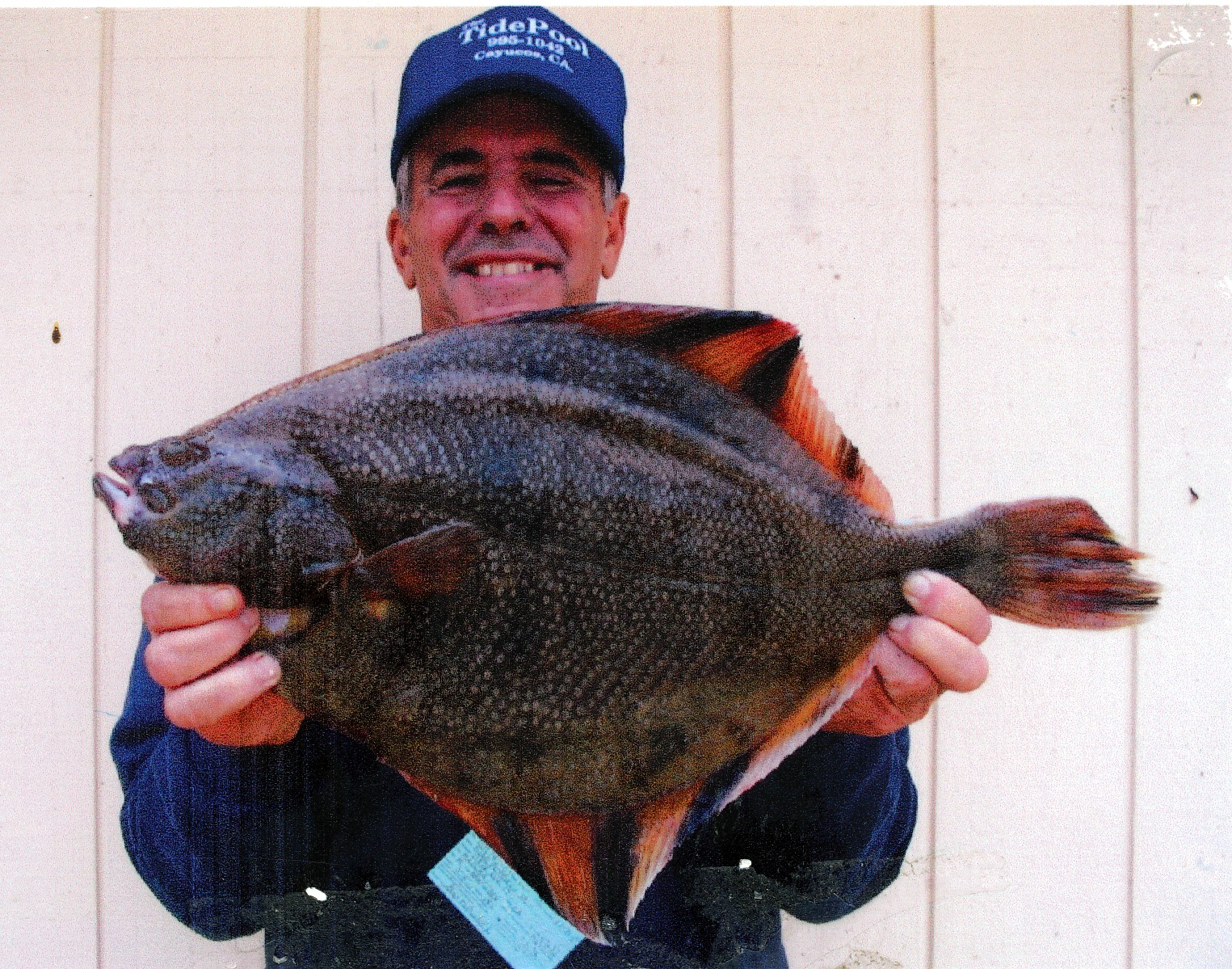
Starry flounder from the Cayucos Pier in 2008 — Picture courtesy of Glenda at The Tidepool
Could da’ books be wrong? Until recently (2002) most authoritarian guides listed the range of starry flounder as south only to Santa Barbara or the Santa Ynez River (near Santa Barbara). However, on July 4, 1962, I caught a fish off of Newport Pier that seemed to match, in every respect, the characteristics of starry flounder: its coloring was the same, it had rough scales, etc. Several source books conflicted on the southern range of this fish, but one old text did include a listing for a southern starry flounder that showed a more southern range. That identification satisfied my biology teacher at Newport Harbor H.S. as well as myself. The guidebooks still do not list starries as extending south to Newport Beach but I will continue to believe that I caught a starry flounder at the Newport Pier on Independence Day, 1962.
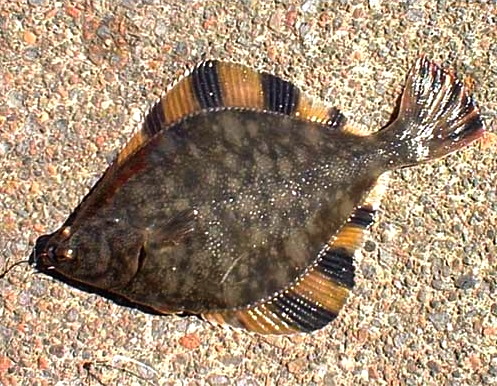
Thanks for sharing information about Flounders fishing.
I’m curious, what piers carry flounders now adays in San Francisco-Bay Area?
I used to fish for halibuts at Berkeley Pier, but the pier has been closed since July 2015.
Please advice for flounders pier fishing locations.
Really appreciate.
I caught a flounder yesterday on my boat but it was just off China Camp so I would imagine that any piers in that area would also have the potential of catching these founders
Great to hear. We used to fish them on and near the Berkeley Pier, but they are pretty much non existent.
The drop in flounder is just about the same time we started to
to have a rise in plastic use. The major rivers along our coast are
the best carriers of farm related plastics and the inland rivers
help deliver non ag. related plastic. I’m not a biologist but I’d bet
my favorite Shimano reel that the fry are eating pieces of broken
down plastic thinking it is plankton or small organisms. My
guess is it clogs their digestive tract and they die becoming
food for larger fish, birds, and possibly mammals. Its not just
the turtle that’s choking on plastic. dust my .02
Used toCatch Flounders these Flounders In Santa Barbara the old mikes tackle had many pictures of big fish caught over the years – they seemed to disappear in late 80’s and 90’s now most people aren’t familiar with them!
If you mean starry flounder, there numbers have really gone down over the years. Of course that was close to the southern range for the flounder.
Starry flounders were abundant in San Francisco Bay in the 1970s and into the 1980s.
They’ve all but vanished from San Francisco Bay and nobody seems to know why.
Neither biologists nor old time anglers and charter boat crews have any answers.
My daughter caught a 14in starry flounder from the bank on 1st street in Benicia.
[…] Off Japan, nearly 100 percent of Starries are left-eyed, but off the west coast of North America most Starries are right-eyed. No one knows why. https://www.pierfishing.com/starry-flounder/ […]
I was to understand that they are considered a ground fish and you cant catch them from a boat in any bays only from the bank. Wandering.